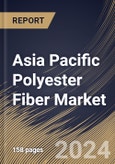Due to its low absorbency, polyester fiber's inherent resistance to stains has increased its utilization in producing apparel, equipment, upholstery, tablecloths, and covers. As an effective, non-allergenic insulator, textured polyester fiber is utilized to stuff pillows, outerwear, quilts, and sleeping bags. However, the volatility in prices of the basic materials utilized in producing polyester fibers - crude oil - restrains the expansion of the market.
This fiber is a recyclable material of convenience owing to its thermoplastic properties. The utilization of recyclable polyester products in manufacturing automotive components has gained traction due to heightened environmental consciousness demanding resource conservation. Recycled polyester fiber is suitable for incorporation into automobile upholstery, specifically seat covers and carpets. Moreover, polyester non-wovens are recyclable in the production of new materials. Additionally, polyester resin has the potential to serve as a matrix material for natural fiber composites, thereby facilitating the repurposing of byproducts formerly utilized in the assembly of automobile components (e.g., boot liners, headliners, and parcel shelving).
The industrial sector in China has witnessed a growing need for technical textiles and industrial fabrics. With their strength and resistance properties, polyester fibers are utilized in applications such as geotextiles, filtration materials, and reinforcement fabrics. The ongoing infrastructure development projects in China, including roads, bridges, and buildings, drive the demand for polyester fibers in the construction industry. The home textiles and furnishings sector in China is a major consumer of polyester fibers. These fibers are used in products like carpets, curtains, and bedding. The growing middle-class population and urbanization contribute to the demand for home textiles. Therefore, the factors mentioned above will propel the market growth in this region.
The China market dominated the Asia Pacific Polyester Fiber Market, By Country in 2022, and would continue to be a dominant market till 2030; thereby, achieving a market value of $18,070.7 million by 2030. The India market is exhibiting a CAGR of 8.3% during (2023 - 2030). Additionally, The Japan market would experience a CAGR of 6.8% during (2023 - 2030).
Based on Form, the market is segmented into Solid, and Hollow. Based on Grade, the market is segmented into PET Polyester, and PCDT Polyester. Based on Product Type, the market is segmented into Polyester Staple Fiber (PSF), and Polyester Filament Yarn (PFY). Based on Application, the market is segmented into Textile & Apparel, Automotive & Transportation, Home Furnishing, Industrial, and Others. Based on countries, the market is segmented into China, Japan, India, South Korea, Singapore, Malaysia, and Rest of Asia Pacific.
List of Key Companies Profiled
- Reliance Industries Limited
- Toray Industries, Inc.
- Sinopec Group (China Petrochemical Corporation)
- The Bombay Dyeing & Manufacturing Company Ltd. (Wadia Group)
- Indorama Ventures Public Company Limited (Indorama Resources Ltd.)
- Green Group SA.
- W.R. Grace & Co. (Standard Industries)
- Markische Faser GmbH
- Stein Fibers Ltd.
- Nan Ya Plastics Corp. (NPC)
Market Report Segmentation
By Form (Volume, Kilo Tonnes, USD Billion, 2019-2030)- Solid
- Hollow
- PET Polyester
- PCDT Polyester
- Polyester Staple Fiber (PSF)
- Polyester Filament Yarn (PFY)
- Textile & Apparel
- Automotive & Transportation
- Home Furnishing
- Industrial
- Others
- China
- Japan
- India
- South Korea
- Singapore
- Malaysia
- Rest of Asia Pacific
Table of Contents
Companies Mentioned
- Reliance Industries Limited
- Toray Industries, Inc.
- Sinopec Group (China Petrochemical Corporation)
- The Bombay Dyeing & Manufacturing Company Ltd. (Wadia Group)
- Indorama Ventures Public Company Limited (Indorama Resources Ltd.)
- Green Group SA.
- W. R. Grace & Co. (Standard Industries)
- Markische Faser GmbH
- Stein Fibers Ltd.
- Nan Ya Plastics Corp. (NPC)
Methodology

LOADING...








